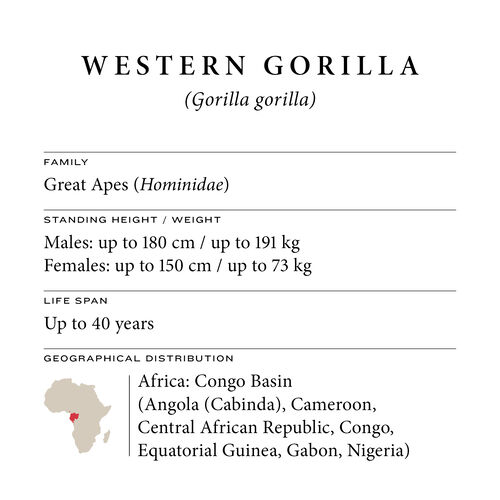Western Gorilla
Gorilla gorilla

HABITAT
Members of the Gorilla gorilla species can be divided into two subspecies: the Western Lowland Gorilla (G. gorilla gorilla) and the Cross River Gorilla (G. gorilla diehli). Western Lowland Gorillas live in moist and rain forests, bog forests, and secondary forests at elevations up to 500 metres above sea level. Cross River Gorillas, meanwhile, prefer hilly, craggy lowland and montane forests that are difficult for humans to traverse. They can typically be found at elevations of 200 – 2,000 metres above sea level.
BEHAVIOUR
Western Gorillas are active during the day and build themselves nests of leaves and branches (usually on the ground) for sleeping at night. Most groups comprise between 10 and 20 Gorillas, which are led by a dominant male referred to as the “silverback”.
NUTRITION
Western Gorillas feed predominantely on fruits and herbs, but leaves, shoots and bark are also on the menu.
REPRODUCTION
The competition for female mates is quite fierce among male Gorillas. A Western Gorilla silverback is only able to reproduce after achieving dominance in a group, at which point he has sole claim to all the females therein. Following a gestation period of eight to nine months, females typically give birth to a single infant. Young Gorillas are highly dependent on the care of their mothers, who nurse them for around four to five years.
STATUS
IUCN RED LIST
Critically endangered
POPULATION
Cross River Gorilla: fewer than 300
Western Lowland Gorilla: approx. 360,000
TREND
Numbers of Western Lowland Gorillas continue to decline. Studies revealed an overall population reduction of one fifth between 2005 and 2013. According to forecasts, we could lose more than 80 per cent of the species between 2005 and 2071.
THREATS
Gorillas depend on forests because that is where they find their food. However, the mining of natural resources, road construction, and illegal forest-clearing activities continue to push them out of their preferred habitat. Infectious diseases (such as ebola) and poaching (due to the widespread popularity of their meat) are also putting the survival of these Gorillas at risk.
CONSERVATION
WHAT WWF IS DOING TO PROTECT THE SPECIES
– Preservation of the rainforest (part of the Gorillas’ habitat) in the Dzanga-Sangha Protected Area Complex
– Biomonitoring as a means of researching the numbers and locations of the Gorillas, as well as related population trends
– Observation of Gorilla groups habituated to humans in order to research and protect the species; watching Gorillas as a form of ecotourism also provides an alternative source of income for local communities
Stay tuned. We are going to reveal more in the next couple of days! Sign up for our Monkey News here!





















